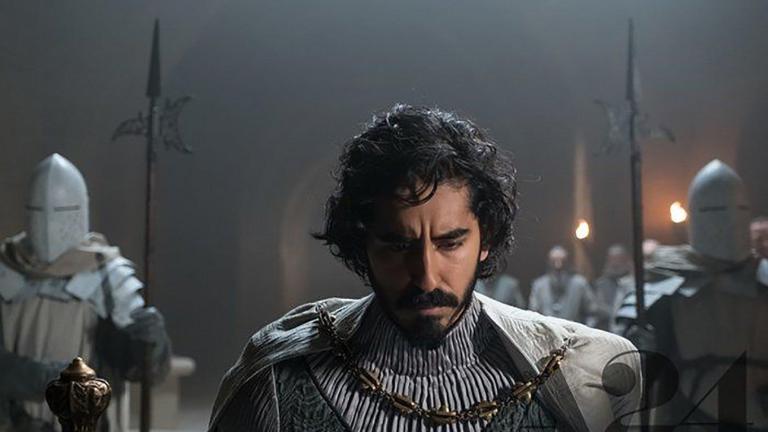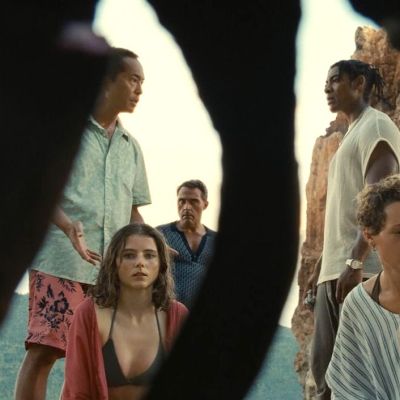The Green Knight Ending Explained
The Green Knight turns Arthurian lore on its head during its closing moments, answering what it means to be an honorable man.

This article contains The Green Knight spoilers.
A man who would be king lies crouched, cowering on his hands and knees. It is the day he’s feared all year and, seemingly, the hour of his death. And yet, within this moment, after he’s seen his life flash before his eyes, Dev Patel’s Gawain has never appeared taller or more free from the terror of self-doubt. The character is still not technically a knight, but as he throws away a magical green sash and asks his executioner, a Green Knight made of bark and flower, to do his worst, Gawain truly has achieved the greatness he’s striven for in King Arthur’s shadow.
This is why Ralph Ineson’s imposing emerald warrior leans down and whispers like a kindly grandfather his approval. That’ll do, Gawain, that’ll do. “Now little knight,” he adds, “off with your head.”
I’m sure that jarring and abrupt final line has left many an audience shocked and maybe even a bit confused. After all that, did the vision Gawain had of himself assuming Arthur’s throne come to naught? And did the flawed hero we’ve watched for two hours only achieve true chivalric virtue in the same minute as his death, which the Green Knight promises is about to occur off-screen? Also why did any of this happen?
There is much to unpack about David Lowery’s poignant and often surreal interpretation of Sir Gawain and the Green Knight, but there is sound reason for why the absolute happiest ending for poor Gawain is the one that concludes with his swift decapitation.
The Ending of the Original Green Knight Poem
Perhaps the most striking thing about the ending of The Green Knight is how it both complements and changes the resolution of the 14th century epic poem upon which it’s based. Tackling a ballad that profoundly affected him when he first read it as a teenager, and even more so when he chose it to be the template for a film, Lowery is unsurprisingly close to many of the smallest details in the 800-year-old story.
For instance, the first line of dialogue spoken by a character in the film—when Alicia Vikander’s Essel says “Praise the Lord, Jesus Christ was born”—is taken from how the anonymous author describes Gawain’s first thoughts every morning he’s awakened. However, in Lowery’s The Green Knight, that awakening occurs on the actual Christmas morning and the person who speaks the words to Gawain is a prostitute whom he spent Christmas Eve with. It’s hardly an auspicious time to be talking about Christ, but then again, Essel is arguably the most virtuous character in the film due to her guileless practicality.
Such is one example of how the film follows the plot of the poem while adding often challenging context and subtext to its medieval values. Which in the film’s climax comes when we meet Vikander again in the role of a different character: the Lady of a manor married to a jovial Lord played by Joel Edgerton. They live in high Middle Ages luxury with an unexplained older woman who is apparently blind and mute, and they ensnare Gawain into an odd game: Edgerton’s Lord will gift any animal he kills in his hunts during the day, and Gawain will share with his Lord any gift he might receive in the house. When that gift comes in the unexpected form of seduction from the Lord’s wife, Gawain is forced to reluctantly kiss his host on the lips, all while still hiding that he received an allegedly magical green girdle as a present from her.
These events all occur in Sir Gawain and the Green Knight, however they occur with a different meaning here. On the page, Gawain is able to resist the Lady’s advances on three separate occasions, as opposed to instantly capitulating on-screen. And while he proudly kisses his Lord on the mouth in the poem, he still hides that the Lady gave him a magical sash which will keep him safe from the Green Knight’s axe. This becomes crucial at the end of the poem since when Gawain encounters the Green Knight again in the Green Chapel, his grassy-hued foe reveals he’s the same Lord of the manor played by Edgerton in The Green Knight!
As it turns out, the Lord was turned by magic into the indestructible Green Knight by Morgan le Fay, King Arthur’s half-sister who also via magic disguised herself as the old blind woman living in that strange manor. Further, this entire charade was never meant for Gawain; it was orchestrated in the hopes of a king’s man beheading the Green Knight, who would then not die. It’d be such a shocking sight, Morgan thought, it would scare Queen Guinevere to death.
In 14th century Arthurian lore, Morgan le Fay was not yet the chief antagonist of the tales, but she was still an ambiguous presence. Gawain’s journey into learning that even for all his virtue he was still fallible since he hid the green sash from the Lord is almost narrative happenstance.
That is how Sir Gawain and the Green Knight ended in the 14th century. But is that actually what’s occurring at the end of the 2021 movie, with the Lord and Lady in league with an unseen Morgan le Fay? Yes… and no.
The Game Being Played By Gawain’s Mother
While the ending of The Green Knight’s source material reveals the titular character is Edgerton’s Lord in disguise, that’s obviously not what Lowery’s film is about. Indeed, we see how the Green Knight is summoned by Gawain’s unnamed mother in the film, risen from the weeds of the earth as if he were the pagan deity we call “the Green Man” made flesh.
There is definitely a pagan witchiness to the woman played by Sarita Choudhury. She openly refuses to go to her kingly brother’s Christmas Day feast and instead uses Wiccan-like magic to summon a champion born from nature. We know she is in league with the Green Knight, but it is not immediately clear to what end. All that’s evident is when she hides beneath a blindfold, she is at the Camelot feast in spirit when the Green Knight intrudes.
In Arthurian lore, Gawain’s mother is named Morgause, and she is one of Arthur’s several estranged half-sisters. In fact, before the sorceress Morgan le Fay was depicted by post-19th century texts as the ultimate villain of Arthurian tales, even birthing Arthur’s would-be usurper Mordred, it was Morgause who gave birth to both Gawain and Mordred in Le Morte d’Arthur, the latter by incest after sleeping with her half-brother Arthur.
When we spoke with writer-director Lowery about The Green Knight, we asked if he intentionally blended the Morgan le Fay of the original Sir Gawain and the Green Knight tale with Gawain’s mother.
Says Lowery, “Very pointedly we did not give any of the characters, other than Gawain, Essel, and Winifred, a name. No one is named. King Arthur is just ‘the King.’ Merlin is just ‘the Wizard.’ So Morgan le Fay in our story is Gawain’s mother. And we wanted to embrace what the original poem did, which was have Morgan le Fay be the character who is behind it all, but I wanted to make her aim, her plot integral to Gawain’s journey.”
He continues, “In the original poem, Gawain sort of just accidentally intercepts this devious plot to scare Guinevere to death, and he gets in the way. But he was not meant to play a role in what Morgan le Fay was conjuring that day, that Christmas morning. So I wanted to honor her role in the story but also make it still revolve around Gawain. And the way I ultimately realized I could do that was to combine the character of Gawain’s mother with Morgan Le Fay and make them one and the same.”
The alteration also changes why the Green Knight came to Camelot that day, as well as what the green sash really means for Gawain. In the original text, it really did not matter who attempted to behead the Knight in the Yuletide game, but in The Green Knight, Gawain taking the challenge may or may not be the entire crux of his mother’s plan.
While it is open to interpretation, I think the Green Knight was personally intended for Sean Harris’ enfeebled King Arthur, who is the only man at the Round Table eager to meet the challenge. He’d have done it too, if not for the weakness in his hands (also a change from the original story). So there’s a scenario that could’ve occurred where Arthur beheaded the Green Knight and then was doomed to spend a year getting his affairs in order before meeting the foe again next Christmas.
However, there is the other added wrinkle in the movie that the Green Knight gives Gawain an out. He explicitly says that it’s Gawain’s choice to strike him as hard as he wishes or to leave but a scratch. Arthur cautions his nephew to remember “it’s just a game,” and Guinevere is clearly heartbroken when Gawain lops the Green Knight’s head clean off. The royals knew that was the losing strategy.
I would argue, then, that is why Choudhury’s Morgan gives her son his first green sash. She intends for her son to be king, just as how modern interpretations of Morgan le Fay have her angling for Mordred to usurp Arthur. (It should also be noted The Green Knight implies Mordred exists in this film’s universe since Arthur asks Gawain to take an empty chair next to him, intended for another who’s left.)
Who Is Alicia Vikander’s Lady of the Manor?
The green sash is supposed to be Gawain’s salvation, which brings us back to Vikander and Edgerton’s Lord and Lady. By the time that Gawain reaches their home, he has lost the girdle, and much of his integrity, while on the quest. Ergo, the house’s waiting occupants are there to tempt Gawain’s virtue, as opposed to test it.
As Lowery says, Morgan le Fay has much the same function here as she does in the original story, and that includes her being the mastermind disguised as a frail old woman. Consider that the blind woman Gawain always sees in the presence of Vikander’s Lady wears the exact type of blindfold Gawain’s mother wore while summoning the Green Knight. She is there to ensure her son receives a second green girdle that will have magical properties to keep him safe.
Which brings us to the actual seduction. In the text, Vikander’s Lady is there to test Gawain’s virtue. On the screen, she is determined to shatter it, hence the curious dual casting of Vikander as both Essel, the prostitute who Gawain maybe loves, and the courtly Lady who so easily dissuades him of his concerns about coveting another man’s wife.
A surface level reading might be about the limited ability Gawain has to adhere to the Chivalric Code, in which men strive to be noble and all women are reduced to wilting flowers and possessions for their lordly masters. In this sense, all women look somewhat the same to Gawain. Indeed, such assumptions are repeatedly challenged on screen as he’s bested by multiple women, beginning with the pair of thieves who actually capture him and steal his first green sash, and now again by the woman who gives him another sash by appealing to his lustful desires.
But such a reading misses the larger themes at work, as well as the implicit magic at play in Vikander and Edgerton’s home. Their castle is more than just a refuge, and her Lady is more than just a seductress. In the scene where she climbs atop Gawain, she only breaks his (meek) protestations by asking if he believes in witchcraft and magic. Like any good man of the Middle Ages, he says of course.
Only when she mentions magic and offers a green sash like Gawain’s witchy mother did, does Gawain abandon any pretense of virtue, succumbing to the lady’s beauty and her magic. He is surrendering to a fear of death as much as lust, knowing on a primal level if he gives in to her, the magic she promises will save his life from the Green Knight’s blade.
This entire house was designed by his mother and her coven as a trap to seduce and protect Gawain via his foibles. If you pay attention early on in the film, one of the nameless weird “sisters” who help Morgan summon the Green Knight has the same hairstyle Vikander does when Gawain first arrives at that house. As Gawain’s mother has taken on the countenance of an old blind woman, another witch (and possibly Gawain’s actual sister) has taken on the appearance of the woman Gawain loves but is too foolish to wed. He refuses to take Essel as a wife because of her lowly stature, yet allows himself to be beguiled by her face when it belongs to a highborn “Lady,” despite said Lady being another man’s wife.
Gawain’s mother wants her son to have the sash as it will keep him safe, and allow him to return to Camelot as a hero and true heir to Arthur. Which is why Gawain’s final decision is so significant.
The End of Brave Sir Gawain
All of which brings us back to the Green Chapel and Gawain’s decision to confess he is wearing a magical green girdle—and to then throw it away. Moments before this, Gawain has a vision of what his life would be if he survived the Green Knight’s axe, either by magic or cowardice. He runs away and returns home, claiming to have survived his quest with honor.
In silent montage, we see what kind of honor playing political games and giving into ambition provides him. He becomes king and marries a woman he doesn’t love. Meanwhile, the woman he does love, Essel, is abandoned after Gawain steals their son from her. In the end, he lives a life of feigned honor, hidden behind the false security and protection the green sash gives him. Unlike his uncle, he does not offer Camelot a golden age: There is only death and ignominy from such a cautious self-serving path. And in 20 years’ time or so, he still will lose his head.
All of that flashes before Gawain’s eyes at the moment of his greatest fear: the Green Knight’s axe falling. Up to this point, he’s attempted to look as majestic as a knight (or king), but throughout the film he has failed time and again to be truly virtuous. He was taken by a band of ruffians in the wood where he begged for his life; he first requested payment from the ghost of a murdered girl instead of simply helping her find peace; and then he received the green sash through a moment of monstrous infidelity and carnal surrender.
As Vikander’s Lady says, red is the color of passion, and green the color of passion the morning after. His green sash represents both life and death, bloom and decay, and it’s stained with the literal seed of his sin. To wear it might allow him to cheat death today, but it instills a lifetime of cowardice. A stain on his honor.
Likely his mother suspected second-guessing, which is why she also took the shape of a fox to warn her son that he may face his doom if he meets the Green Knight—we know the fox is really Morgan because in the animal’s final scene it speaks with the voice of Gawain’s mother.
So in the movie’s final moments, Gawain understands all of this, and the ignoble road his nature is leading him on, and he finds the courage his mother feared: He takes off the sash and faces the Green Knight’s axe fair and square.
This is the thematic crux of the original text too. As Lowery tells us, “He ultimately fails [in the poem], Gawain does not live up to the Chivalric Code to which he’s bound. When he kneels before the knight with the girdle on, he is approaching his state with cowardice in his heart. So I wanted to take that fallibility and present a more binary version of it and have a character who is not yet the knight of legend but who has room to grow into that.”
And yet, Lowery has also changed the meaning of that ending, including Gawain’s fate. In the poem, Gawain does not tell the Green Knight he wears the sash (just as he hid it from the Lord), because he fears death in spite of all his virtue. In the film, Gawain is a man who spends Christmas morning in a brothel and has lived his whole life without real honor. But in the moment where it most counted, he became a true knight by taking the girdle off.
It is a complete reversal of the poem’s ending, turning this into a story about living in peace with yourself, as opposed to an impossible Code thrust on you by society. In many ways, it’s like Vikander’s Lady also saying she changes the stories she reads when she sees room for improvement—although Lowery tells us that line was not intended to be self-referential about how he adapted the poem.
“I knew I would get in trouble for it,” the director laughs. “I don’t know what was going through my head when I wrote that, but Alicia just fell in love with it.” He even almost cut the line in post-production until Vikander convinced him to keep it in.
Intentional or not, the Lady’s admission is what the entire ending of the movie is about. Gawain has found grace and true nobility, improving himself and his story. Unfortunately for Gawain, true chivalric virtue is no shield, and by finding it he’s also found his last act. Thus the Green Knight’s final line. “Now little knight, off with your head.”
If you can live with yourself, you can also die in peace. That’s chivalrous.




